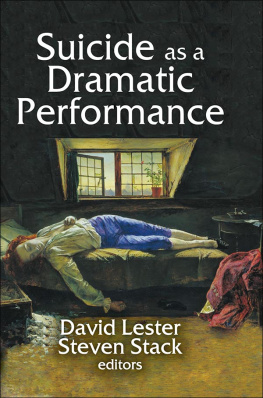First published 2015 by Transaction Publishers
Published 2017 by Routledge
2 Park Square, Milton Park, Abingdon, Oxon OX14 4RN
711 Third Avenue, New York, NY 10017, USA
Routledge is an imprint of the Taylor & Francis Group, an informa business
Copyright 2015 by Taylor & Francis.
All rights reserved. No part of this book may be reprinted or reproduced or utilised in any form or by any electronic, mechanical, or other means, now known or hereafter invented, including photocopying and recording, or in any information storage or retrieval system, without permission in writing from the publishers.
Notice:
Product or corporate names may be trademarks or registered trademarks, and are used only for identification and explanation without intent to infringe.
Library of Congress Catalog Number: 2015004387
Library of Congress Cataloging-in-Publication Data
Suicide as a dramatic performance / edited by David Lester & Steven
Stack.
pages cm
Includes bibliographical references.
ISBN 978-1-4128-5694-2 -- ISBN 978-1-4128-5661-4 1. Suicide-
Case studies. I. Lester, David, 1942- editor. II. Stack, Steven, editor.
HV6545.S828 2015
362.28--dc23
2015004387
ISBN 13: 978-1-4128-5694-2 (hbk)
Contents
David Lester & Steven Stack
Joseph Rubenstein
David Lester & Bijou Yang
David Lester
David Lester
Jermaine Martinez
Steven Stack
Steven Stack
Steven Stack
Steven Stack
Steven Stack & Barbara Bowman
David Lester
David Lester
David Lester
John F. Gunn III
Steven Stack & Seth B. Abrutyn
Steven Stack
Steven Stack
Steven Stack
David Lester
David Lester
David Lester
David Lester
David Lester
David Lester
David Lester & Steven Stack
All the worlds a stage,
And all the men and women merely players;
They have their exits and their entrances,
And one man in his time plays many parts...
William Shakespeare, As You Like It
1
Introduction
David Lester and Steven Stack
Gertrude Stein once said, A rose is a rose is a rose. For many of those who study suicide, it might similarly be said, A suicide is a suicide is a suicide. We talk of the risk of suicide and the rate of suicide, implying that all suicides are the same. Of course, suicide is engaged in by different people men and women, the young and the old, and psychiatrically disturbed and nondisturbed people. But the nature of their act is rarely examined.
Consider two suicidal acts. On November 25, 1970, in Tokyo, Japan, Yukio Mishima, aged forty-five and a successful Japanese novelist, decided to take his paramilitary force, invade an army base, and persuade the soldiers there to overthrow the Japanese government and restore the Emperor to absolute power. The soldiers refused to follow his commands. Mishima then committed seppuku. He took a knife and ripped his abdomen open, and then his loyal assistant decapitated him.
What a death! Mishima orchestrated his suicide, and the report of his suicide by the media captured worldwide attention. The setting of his suicide, the manner of his suicide, and the timing of it all added to the dramatic aspects of the act.
Consider the suicidal attack on the twin towers of the World Trade Center on September 11, 2001, by two planes led by Mohamed Atta. This act of martyrdom for an Islamic cause created images that haunt us still today. The planes hitting and damaging the towers, the response of those rushing to the towers, the collapse of the towers, and the scenes of people fleeing the sceneall of these images added to the impact that Atta and his team had hoped to create. However you might label or judge those involved in this attack, you cannot deny the drama created by their actions.
This book is intended to view suicide from this dramatic perspective. We will examine to what extent suicidal acts (or at least some suicidal acts) can be viewed from a theatrical perspective. We will explore how suicides can choose the timing, setting, method, and other circumstances of their suicide to heighten the impact on others and to frame their suicide in a way that they choose.
What happens in the hours, minutes, and second before a suicide? If others are present, what are the interactions? On January 29, 1977, Freddie Prinze, the television actor, shot himself in a room with his business manager present. On December 1, 2012, Jovan Belcher, a linebacker for the Kansas City Chiefs NFL team, shot himself in the parking lot of a football stadium after talking to his coach, Romeo Crennel. What is the nature of the interactions between the suicidal individual and the bystanders? And what role does this interaction have on the outcome?
Let us give an example from the study of murder. Only one study has looked at the interpersonal interactions between murderer and victim. Luckenbill (1977) analyzed the act of murder as a dynamic interchange between the murderer and the victim. In Stage 1, the victim does something that the offender defines as an offense to face, an insult, a refusal to comply, or a nonverbal gesture. In Stage 2, the offender interprets the victims action as personally offensive, often with the victim and bystanders providing information for this interpretation (in 60% of the incidents). In Stage 3, the offender makes a retaliatory move to restore face, such as a verbal or physical challenge (in 86% of the incidents) or an actual murderous act (in 14% of the incidents). In Stage 4, the victim responds either with noncompliance (41%) or an attack (30%). The bystanders (present in 70% of the incidents) may at this point encourage the attack (57%) or remain neutral (43%). In Stage 5, the victim is killed. In Stage 6, the offender may flee (58%), stay voluntarily (32%) or, in rare cases, be held at the scene by the bystanders (10%). This type of study has never been conducted on suicide carried out in the presence of others.
Those who die by suicide alone leave a suicide note. Does this suicide note provide insights into the mind of the suicides? Or it designed merely to present themselves to others in a particular way? There are other ways that the suicidal person can communicate to others, such as using Twitter and YouTube, or even live on television. Does the timing of the suicidal act have significance? Does the suicide choose daytime or nighttime? It has been claimed that there is a birthday effect in suicide, that many suicides kill themselves close to the time of their birthday. What does this signify?
What about the way suicides dress themselves? Are there common choices of clothing and does the choice of clothes have any psychological meaning? The thirty-nine members of the Heavens Gate cult, who died by suicide together on March 26, 1997, all clothed themselves identically and positioned themselves in their beds in the same way.
Suicides choose a location for their suicide. This is typically at home, but many die by suicide away from home. Very little is known about the characteristics of those who choose to die away from home. What factors, psychological, social, and cultural, influence this choice? Wasserman and Stack (2008) have written on the notion of














